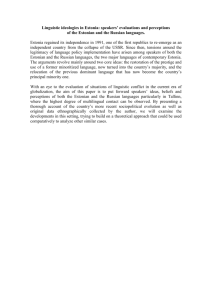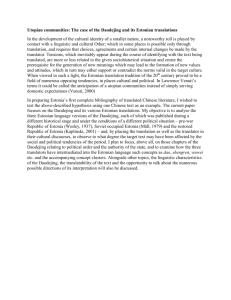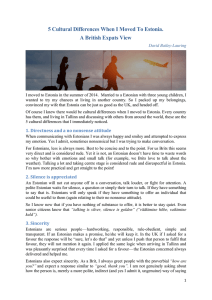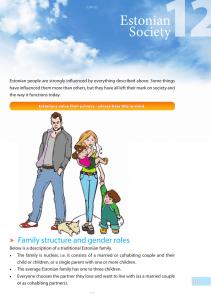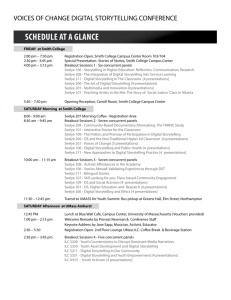Cultural Aspects
advertisement
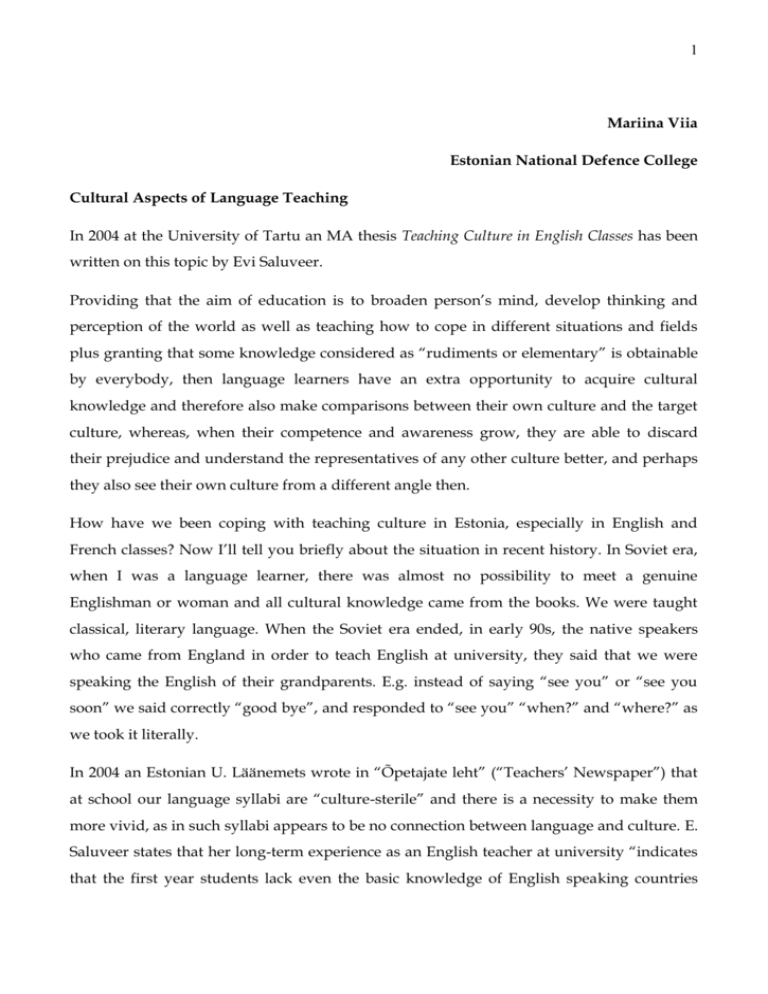
1 Mariina Viia Estonian National Defence College Cultural Aspects of Language Teaching In 2004 at the University of Tartu an MA thesis Teaching Culture in English Classes has been written on this topic by Evi Saluveer. Providing that the aim of education is to broaden person’s mind, develop thinking and perception of the world as well as teaching how to cope in different situations and fields plus granting that some knowledge considered as “rudiments or elementary” is obtainable by everybody, then language learners have an extra opportunity to acquire cultural knowledge and therefore also make comparisons between their own culture and the target culture, whereas, when their competence and awareness grow, they are able to discard their prejudice and understand the representatives of any other culture better, and perhaps they also see their own culture from a different angle then. How have we been coping with teaching culture in Estonia, especially in English and French classes? Now I’ll tell you briefly about the situation in recent history. In Soviet era, when I was a language learner, there was almost no possibility to meet a genuine Englishman or woman and all cultural knowledge came from the books. We were taught classical, literary language. When the Soviet era ended, in early 90s, the native speakers who came from England in order to teach English at university, they said that we were speaking the English of their grandparents. E.g. instead of saying “see you” or “see you soon” we said correctly “good bye”, and responded to “see you” “when?” and “where?” as we took it literally. In 2004 an Estonian U. Läänemets wrote in “Õpetajate leht” (“Teachers’ Newspaper”) that at school our language syllabi are “culture-sterile” and there is a necessity to make them more vivid, as in such syllabi appears to be no connection between language and culture. E. Saluveer states that her long-term experience as an English teacher at university “indicates that the first year students lack even the basic knowledge of English speaking countries 2 (such as name and location on the map)” (Saluveer 2004; 16). Stern (1992; 207) draws attention to the following reasons for limited treatment of culture: the vastness of the culture concept; the problem of goal determination and lack of accessible information; question of syllabus design and finding place to culture in a predominantly language-oriented curriculum; questions of teaching procedure. I would also add the scope of teachers’ cultural awareness, since I am convinced that for better teaching a person must first not only understand but also have an experience of the culture she/he is teaching, because at university level we are all supposed to be able to read books, but how many of us are provided with personal experience of living in the target culture? Yet the experience of sharing local life is the best teacher and it is clear that neither school nor universities can afford to send all their students abroad for learning from experience, then at least teachers should have a possibility for such a cultural stay, but still it is not a common experience. I have lived in France for two years thank to the French Cultural Institute in Estonia and this was most valuable experience for my future career as a teacher. What are the main goals for teaching culture? “When the aim of the foreign language teaching is to develop students’ ability to communicate effectively and appropriately in various situations, the teaching of culture should facilitate intercultural communication and understanding. Seelye formulates what he himself calls a super goal for teaching culture: “All students will develop the cultural understanding, attitudes and performance skills needed to function appropriately within a segment of another society and to communicate with people socialized in that culture (Seelye 1993; 29). Chastain (1988; 299f) adds that, in language classes where intercultural understanding is one of the goals, students become more aware of their own culture and more knowledgeable about the foreign culture. In such classes, students learn to recognize cultural patterns of behaviour and communication, and function within the parameters with those new expectations.” (Cf Saluveer 2004, 17). Therefore the large goals should be 3 described in more detail. Seelye suggests “six instructional goals, which he summarizes as follows: the teacher should “help the student to develop interest in who the target culture did what, where, when, and why” (the first five goals) and some sophistication in evaluating statements about the culture and finding out more about it (the sixth goal). Tomalin and Stempleski (1993; 7f) have modified Seelye’s goals of cultural instruction, formulating 7 main aims. According to them, teaching of culture should help students 1) to develop an understanding of the fact that all people exhibit culturally conditioned behaviours; (e.g. body language differs according to the culture) 2) to develop an understanding that social variables such as age, sex, social class, and place of residence influence the way in which people speak and behave; (School slang) 3) to become aware of conventional behaviour in common situations in the target culture; “Greetings, friendly exchange, farewells: How do friends meet, converse briefly, take their leave?” (Kumaravadivelu 2008; 93) 4) to increase their awareness of the cultural connotation of words and phrases in the target language; “Patterns of politeness: What are the commonest formulas of politeness and when should they be used? Verbal taboos: What common words and expressions in English have direct equivalents that are not tolerated in the new culture and vice versa?” (Kumaravadivelu 2008; 93) 5) to develop the ability to evaluate and refine generalisations about the target culture, in terms of supporting evidence; 6) to develop the necessary skills to locate and organize information about the target culture; “Festivals: What days of the calendar year are officially designated as national festivals? What are the central themes of these occasions and what is the manner of their celebration? Races, circus, rodeo: What outdoor events are in vogue that correspond to our auto or horse races, circuses, and similar spectacles?” (Kumaravadivelu 2008; 93) 4 7) to stimulate students’ intellectual curiosity about the target culture, and to encourage empathy towards its people. (Cf Saluveer 2004; 18f) As we see here and have to agree with Stern that all listed goals stress the cognitive aspect: “knowledge about the target cultures, awareness of its characteristics and difference between the target culture and the learner’s own culture.”” (Saluveer 2004; 18). B. Kumaravadivelu has said: “Although identity and difference co-exist, it is difference that most often stands out in marking one’s identity. There is no identity without difference because one’s identity is largely characterized in terms of how different somebody is from somebody else. Each of us can justifiably say that “I am who I am because I am not you,” or, in the words of Amin Maalouf (2000; 10): “My identity is what prevents me from being identical to anybody else.” Even if we closely align ourselves to a particular community based on ethnic, religious, or other affiliations, we still strive to maintain our own individual identity by positioning ourselves in opposition to others within that community. Therefore, postmodern identity is better seen as “a structured representation which only achieves its positive through the narrow eye of the negative” (Hall, 1991; 21)” (Kumaravadivelu 2008; 144f) – This is the idea of a postmodern identity of one’s self and as teachers we have to consider it when tackling different cultural aspects of any society. Presumably our objective is to teach the culture of the modern society, and every new generation is different, the cultural gap between generations being notably large since 1990s, when we entered the era of computers and mobile phones. Byram and Morgan (1994; 51f. 53ff) suggest “one community where the language is spoken to be taken for a closer study and offer nine broader analytical categories which should make up a minimum content of cultural learning. The categories include social identity and social groups (e.g., social class, sub-culture identities and ethnic and cultural minorities); social interaction (e.g. verbal and non-verbal behaviour, greetings at different levels, gender relationship and taboos); belief and behaviour (e.g. certain actions such as going to school and going to church and their meanings, and ‘recipe knowledge’, i.e. routine behaviours, e.g. how to use public transport); socio-political institutions (e.g. government, law and order and 5 health care); socialisation and the life-cycle (e.g. schools, family and education), national history (e.g. different periods and events); national geography (e.g. distribution of population, topography, climate and vegetation); national cultural heritage (e.g. embodiments from national culture from past and present); and stereotypes and national identity (e.g. explanations of stereotypes and symbols of national stereotypes and their meanings and national identity).” (Saluveer 2004; 24f) Concerning social interaction, which is one of the first elements that draws attention by people of the target culture, an example can be brought: the Estonians do not use much their body language and can live whole life without expressing much of their emotions, whereas in France such expressionless behaviour is considered sick or problematic: e.g. in Estonian we can fully say that “this was a real great party; I had such a good time; the last night event was just wonderful” without moving any muscle in the face and all locals understand, oh, yes, this was real great what the person experienced. In France it doesn’t work: 1) they cannot understand expressionless speech; 2) even if they do, nobody believes that the event was wonderful, 3) the person is considered real weird and they try to figure out what had gone wrong. This expressionlessness is considered impolite when thanking someone for their hospitality for example: in Estonia you just say “thanks”, in French also emotion is obligatory to be added. What was surprising to me when I lived in France, was that the children were taught to say “hello” or “thank you” very personally: “good morning, mother”, “good morning, father”; “thank you, mother”; “thank you, father”. In a family or friends gatherings each person is greeted personally, whereas compared to Estonian culture, here we just say something like “hello (everybody in brackets)” or “thanks” without really addressing to the person. Maybe in modern language classes video lesson help to discern the difference, but the best teacher is personal experience. In conclusion: The idea of teaching culture is to provide a student with a more or less solid basis for understanding the other cultures, via comparing and contrasting with the student’s own visions of their identity. 6 Ways of Teaching Culture Stern (1992; 223) “distinguishes between three situations in which the teaching of culture does take place: 1) Culture is taught in language courses, where students are physically and often psychologically removed from the reality of the second culture. In this case culture teaching provides background and context and helps the leaners visualise the reality. This seems to be the most common situation for teaching culture in many countries, including Estonia. 2) Culture is taught in a situation, which prepares a student for a visit or work in a new environment. Even though the student is physically far away from the culture, he/she is physically better prepared and also more motivated to learn. Considering the enlargement of the European Union and the new opportunities for young people to study and work abroad, this situation may become much more common than it used to be. 3) Culture is taught in the cultural setting (e.g. to immigrants, students studying in a target language community). In this case, students need more help to come to terms with the foreign environment to avoid cultural misunderstandings. (Brown 2000; 189) considers this situation to be the best for second language and culture teaching. Though advisable, it is not the easiest to organise.” (Saluveer 2004, 29f). The latter reminds me a situation in France, where there was a lady in her 50s, a Lebanese(?) immigrant, who came to language courses in order to learn read and write, but she spoke fluent French, just that she had had no time to learn to read because she had been raising her children. Therefore, quoting Saluveer again: “One has to bear in mind students’ age, maturity, command of language and educational level. Byram (1997a; 55f) emphasises that “teaching English and learning aims which include ‘understanding’, ‘tolerance’, ‘empathy’, and related notions, presuppose a psychological readiness in learners which may be age-dependent, may be influenced by social factors, and may be furthered or even inhibited by exposure to a foreign culture and language.” Durant (1997; 31) adds that “enhanced language proficiency is essential”, especially when learners wish to continue their studies independently outside the classroom.” (Saluveer 2004; 30). 7 The world is becoming smaller and smaller, therefore we experience the effects of globalisation very closely. We cannot exclude culture from what we ever do, because each of us represents his/her set of culture via behaviour, use of linguistic expression, and the way of thinking. One possible definition of “language” is that “language is an expression of a culture we belong to”. How far are we able to understand any other culture without having any connection except language learning situation in the classroom? I would say we would not much. Without any previous personal connection or stay for at least few months in any particular country people may take rather deformed point of view about the other culture, judging them to be strange, weird and stereotypical, because they are different from what “our native culture” considers “normal”. E.g. the French as frog eaters – though many French have never eaten a frog. Also, to explain the Estonians that French people kiss each other when meeting in family or among friends, even colleagues, makes these Nordic cold people either giggle or feeling embarrassed, and can be taken as an insult. Saying hello is very easy in Estonian: you just shout „hello“ and if wishing to be extra polite then shake hand, e.g. formal meetings, but also among relatives. Nowadays the globalisation has its effect and it happens that people who feel certain affinity, give a hug. Thus, giving a kiss for greeting is daily politeness in France but indicates an intimate relationship in Estonia. The practice of French friendly greeting in an Estonian French lecture may turn out ridiculous, although people have seen it in French films. The English way of shaking hands is much more understandable and is not embarrassing. “The plural character of culture is the result of the contract between cultural communities and of the consumption of cultural commodities, both of which create the conditions necessary for cultural change. Various forms of migration, some forced and some voluntary, have traditionally been the primary source of cultural contacts among people of different cultural beliefs and practices.” (Kumaravadivelu 2008; 12) Some culture-specific examples from Estonia: 8 * Small talk. We call each other just in case of need, but seldom for a small talk. Our students are very surprised to learn that the English speak about weather not because they are so much interested in it, but because “English weather-speak is a form of code, evolved to help them overcome their natural reserve and actually talk to each other. “Nice day, isn’t?”, “Still raining, eh?” – they are ritual greetings, conversation-starters or default “fillers””. (Fox 2004; 26) “However, in Estonia if you were to say “It’s quite cold today, isn’t it?”, you could get the reply “I do not agree” or “It was minus 5 degrees Celsius last night, which is 8 degrees Celsius higher than the seasonal average. However, the sea remains frozen near Narva to a depth of approximately 18 centimetres.” The only exception to this would be if your host thought you were truly attempting to start serious debate about cold weather, in which case you might find yourself discussing climate change for the rest of the night.” (Bird et al. 2010; 19) * Meeting people in lonely places. If we are alone in the forest and meet somebody there, we do not say hello, because we do not want to disturb the other’s privacy. This way of behaviour shocks the foreigners who happen to wander in the woods. * Eating habits. We do not consider eating as a way of socialization, versus French, who eat because of company. We were taught to eat in silence, except if there is a party. * Language. Some peculiarities of the Estonian Language: we do not distinguish between genders when using possessive pronouns. Estonian language uses the present tense for indicating the future: meaning probably that we live continuously in a present day. 9 Literature: H. Bird; L. Öpik; U. Mustmaa. 2010. Xenophobe’s Guide to the Estonians. Oval Books. K. Chastain. 1988. Developing Second Language Skills. Theory and Practice. Orlando, Florida: Harcourt Brace Janovich Publishers. K. Fox. 2004. Watching the English. The Hidden Rules of English Behaviour. Hodder. B. Kumaravadivelu. 2008. Cultural Globalization and Language Education. Yale University Press. U. Läänemets. 2004. Kriitiline ja ratsionaalne võõrkeele õppes. Õpetajate Leht 7, 20.02.04. A. Maalouf. 2000. On Identity. Trans. Barbara Bay. London: Havill Press. E. Saluveer. 2004. Teaching Culture in English Classes. Master’s Thesis. University of Tartu. H. N. Seelye. 31993. Teaching Culture: Strategies for Inter-Cultural Communication. Lincolnwood; IL: National Textbook Company. H. H. Stern. 1992. Issues and Options in Language Teaching. Oxford: Oxford University Press. B. Tomalin; S. Stempleski. 1993. Cultural Awareness. Oxford: Oxford University Press.
